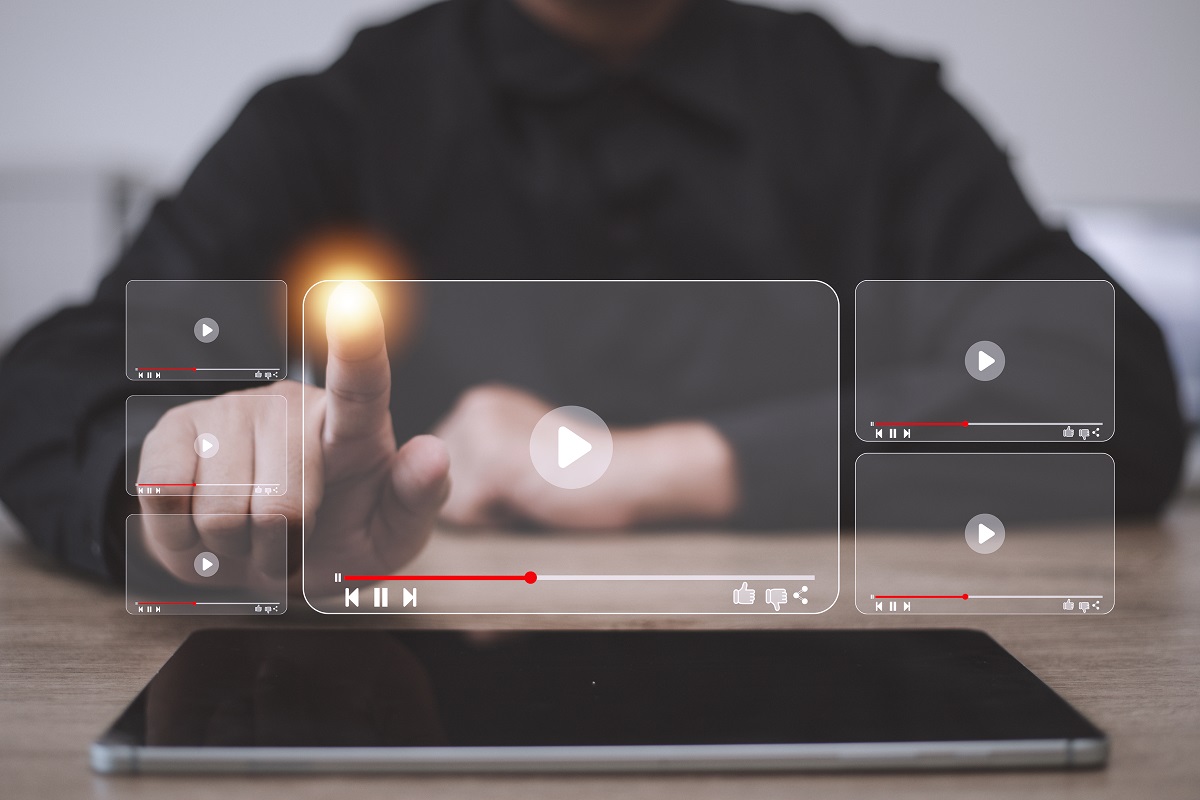Basic Digital Marketing
 The five largest American tech companies are Apple, Amazon, Facebook, Google, and Microsoft. Each of these giants have growing economic, social, and political power not only in the United States, but all over the world.
The five largest American tech companies are Apple, Amazon, Facebook, Google, and Microsoft. Each of these giants have growing economic, social, and political power not only in the United States, but all over the world.
Between them, they control the world’s most important tech, including smartphones, app development and app stores, and social media networks. The influence these five tech giants have is arguably stronger than that of any government. This is nowhere near more evident than in the testimonies of executives from Google and Facebook, admitting in front of Congress how the algorithms embedded in their technology and the platforms themselves may have been used to influence the 2016 election.
There are some who describe the power that these companies have as dangerous. Admittedly, these five corporations have grown to be so big that they’ve literally altered so many aspects of the world we live in. The difficulty in this growing power is that there may not be any real way to stop it from happening or even mitigating the consequences.
Tech can change Society in Unexpected and Messy Ways
Though tech developments have led to some of the most wonderful interventions in history, it does have a dark side. Having 5 massive tech conglomerates, it does provide some good in at least knowing that this is not necessarily a one-company-rules-all situation. That said, modern communication is really dominated by these five brands. Thus far, they’ve been able to be held accountable and seem to communicate genuine interest in ensuring their power is used for positive purposes. That said, the negatives that have come with these five companies are difficult to ignore for some segments of the population that are prone.
 This holiday season, get to know the things you need to do to get your customers ready to shop. Creating a schedule, having measurable goals, and building a personal connection to consumers are all key.
This holiday season, get to know the things you need to do to get your customers ready to shop. Creating a schedule, having measurable goals, and building a personal connection to consumers are all key.
Identify a Schedule to Implement and Measure Holiday Marketing Strategies
Creating the right holiday marketing schedule should be about building momentum. Map out weeks and months with specific goals for each. The goals you target may be different from others companies’ depending on your category of business and your customer base, so remember to customize it according to what you hope to achieve in the weeks to come.
Be More than a Sales Pitch
The holidays should be a time to have fun but instead, consumers are left worrying what to buy. Don’t be sales-y. Develop content that is less aggressive during these months and provide consumers with something they can use, such as an informative blog, tips on throwing the perfect Christmas party, or even some sort of discount code for loyal customers. Just be helpful.
Supply your Audience with what They Want
Monitor social media fans and followers to see what content they care about this holiday season. Remember, customers are being bombarded every day with hundreds of marketing messages during the holiday season. To be successful in your email and social media holiday marketing, you need to know what consumers are most interested in receiving from your business.
 Digital marketing trends are adapting and changing faster than they ever have in the past. Cheap, organic-only strategies are on their way out in favor of paid digital marketing with a mix of high and low rewards.
Digital marketing trends are adapting and changing faster than they ever have in the past. Cheap, organic-only strategies are on their way out in favor of paid digital marketing with a mix of high and low rewards.
To celebrate the New Year, we are counting down the top 7 trends in digital marketing that just don’t work anymore. Though these strategies don’t need to be abandoned outright, you will need to evolve how they are used to adapt in the new marketplace.
Long-Form E-books
Text-heavy e-books are out. No one has time to read them. Mobile internet use has surpassed desktop usage and it’s time to adapt accordingly. The days of long e-books in PDF format are over. Invest that same effort into interactive landing pages, video, and online animation instead.
Drip Campaigns
The days of impersonal email marketing sent out to large contact lists are done. Don’t expect high engagement rates with these anymore. The best solution is to begin with personalized emails using personalized content based in a contact’s demographics, recent engagement level, and consumer behaviour.
 For when you don’t know where to start with your digital marketing goals, studying your competition’s approach is not a bad start. In fact, competitor research is almost a necessity in marketing.
For when you don’t know where to start with your digital marketing goals, studying your competition’s approach is not a bad start. In fact, competitor research is almost a necessity in marketing.
Recognize your Online Competition
In all likelihood, you will be competing against more companies in the online marketplace than offline. By knowing your competition online, you can analyze their websites for the short-tail and long-tail keywords they are best ranked for. There are advantages and disadvantages to competing websites who may be ranking on the keywords you want. The truth is though that in order to gain your own share of marketing space on a search engine like Google, you need to know another site off for their position. That means you need to know what’s making them successful and finding a way to improve on that.
Define where your Competition is winning Engagement
By knowing where your competition are seeing their highest engagement, you can define where their success is coming from. Know where your competition is engaged on in social media, see the opportunities that they are not capitalizing on, and ultimately don’t necessarily assume that there’s any low-hanging fruit. This is merely to see where your competitor’s strategies are winning – not necessarily to provide you with an automated reply to their marketing campaigns by going into spaces you don’t need to be.
 By publishing videos on YouTube, you agree to the site’s Terms of Service. By not respecting that Terms of Service, you run the risk of having your account banned and see real consequences on your business.
By publishing videos on YouTube, you agree to the site’s Terms of Service. By not respecting that Terms of Service, you run the risk of having your account banned and see real consequences on your business.
These three facts about YouTube’s Terms of Service are worth noting for any creator. Every publisher should be aware of these three things. They will save time and money, and will ensure you remain in compliance with all the relevant laws and legislation associated with online video publication.
There’s no Charging to Watch Content
Don’t charge people to watch your video content on YouTube, as agreed on by your commitment to the site’s Terms of Service. There are specific commercial uses not allowed on YouTube, including selling access to content without the written approval of YouTube. For example, creating an instructional video and putting it on a private channel on YouTube, you are not legally allowed to charge people to watch it. If this is what you want to do, you need to host the video on a different platform. Or, upload it to YouTube and then embed that video on another paid-for platform. This is perfectly allowed, as long as the users are not viewing said video directly on YouTube.
 Video marketing maximizes the opportunity for any small business to grow their brand. Approximately
Video marketing maximizes the opportunity for any small business to grow their brand. Approximately
Define in your Video what Makes
Define your area of expertise and find your niche. Any marketing plan, video or otherwise, is dependent upon you figuring this out for your company. For customers to choose you, they need to know what makes you different when they line you up against your competition.
Choose your Target Market and give them something to Talk About
Many videos are played while people are on the move. In fact, more than half of all video content is consumed on mobile devices. That means a consumer looking for instant gratification and with no patience for anything more. Know who your targeting and how to capture their attention in ten seconds or less.
Use Calls-to-Action and answer Questions
Even if it’s adding a few short words at the end of a video, always have a CTA somewhere. Aim to answer questions through a video to give value and credibility to you as a subject matter expert (SME).
 There’s something to gain for both employers and employees in remote work assignments. Remote work has been on the increase in the past decade and that trend is not expected to change any time soon.
There’s something to gain for both employers and employees in remote work assignments. Remote work has been on the increase in the past decade and that trend is not expected to change any time soon.
Every company should be looking at ways to build remote employees and there are numerous reasons why. Though it may not be feasible for some jobs, for the companies that are based in over-the-phone customer service and/or similar tasks, this is something worth considering.
To successfully recruit new generations of employees, it may turn out to be one of the only ways some companies may be able to survive.
Ready to be Deployed in the Event of an Emergency
When hurricanes struck the southern United States earlier this year, some companied relied on remote workers to keep their businesses running. Commuting became nearly impossible and suddenly the value of being able to access work from home came clear.
Though this may not be an option for all companies evidently, some industries have the luxury of allowing employees to work comfortably from home. This is something that can prove to be a necessity in times of emergency or extreme weather.
 Instagram has now made it possible to add guests to live video streams. This is huge news for many who have sought different ways to enhance live video feeds. Live video broadcasting apps and sites have been experimenting with this feature in the past however this is Instagram’s first foray into using it. It is hoped that through the use of adding guests into live video that it can tap into the more than 800 million Instagram users who don’t regularly use live video streaming.
Instagram has now made it possible to add guests to live video streams. This is huge news for many who have sought different ways to enhance live video feeds. Live video broadcasting apps and sites have been experimenting with this feature in the past however this is Instagram’s first foray into using it. It is hoped that through the use of adding guests into live video that it can tap into the more than 800 million Instagram users who don’t regularly use live video streaming.
This update on Instagram’s live video streaming capability builds on a limited test that started in August 2017. Instagram’s live video and messaging application just launched a little under a year ago, and since then, the platform has been looking at ways to encourage more users to engage with it.
How adding guests to Instagram live video streaming works is simple. Anyone live streaming can add anyone watching by clicking on the “add” button in the corner of the screen. When a person is added, that person joins you in a separate window located below yours on screen. For the time being, you can only add one person to your live stream at a time. Therefore, in order to add a second person, you need to remove the first.
Note how on Instagram when friends are using live video and the guest feature, they appear as circles stacked together in the ‘stories’ status bar. Any live video can be discarded after they are done or they can be saved as ‘stories’. After a live video is saved as an Instagram story, it can then be shared on Facebook as well and potentially other platforms in the future. As of now, there are no integrations built-in to collaborate Instagram’s live video with WhatsApp.
 Long-awaited, Google’s mobile-first index has begun to roll out slowly. Though we don’t have a timeline yet on when implementation will be fully completed, an announcement is expected in the near future.
Long-awaited, Google’s mobile-first index has begun to roll out slowly. Though we don’t have a timeline yet on when implementation will be fully completed, an announcement is expected in the near future.
It is not known how many sites have switched to a mobile-first indexing process however it is suspected that it is more than ‘just a few’. In an effort to guard against any issues, Google has committed to rolling out the mobile-first index slowly, testing it every step of the way to ensure it is long-term feasible. Many did not expect the rollout to begin until 2018 however it is expected that positive test results has meant Google getting a jump-start on implementation.
Google has set up ‘classifiers’ to determine whether a given site is ready for a switch-over to a mobile-first index. These classifiers are designed to compare desktop and mobile versions of a site, analyzing content, links, schema, and multimedia among other factors. When there is a 100 percent matchup, it’s likely that site will be taken over to a mobile-first index. If a site reaches an 80 percent matchup, a webmaster may expect communications from Google encouraging changes that need to be made to bring a site closer to 100 percent.
 Pinterest’s boards are based in sharing niche interests through a collection of item. Facebook may have just found a way to one-up them on that point. A Facebook feature known as ‘Sets’ is in the testing phase, letting a user select status updates, photos, and videos, and share them as a themed collection among friends. Already having been deployed among select users, Sets adapts Pinterest-esque thinking into the Facebook model of communication.
Pinterest’s boards are based in sharing niche interests through a collection of item. Facebook may have just found a way to one-up them on that point. A Facebook feature known as ‘Sets’ is in the testing phase, letting a user select status updates, photos, and videos, and share them as a themed collection among friends. Already having been deployed among select users, Sets adapts Pinterest-esque thinking into the Facebook model of communication.
This is not the first time that Facebook has directly attempted to compete with Pinterest. Previously, it launched ‘Collection ads’ that let users save items to a wishlist section of their profile. Facebook also has allowed niche interests in the Newsfeed to be followed and for status updates to be applied to photo albums. Though these moves are similar to what happens on Pinterest, Facebook Sets is a near duplication. Sets simply build from personal content rather than content that has been shared web-wide, for example amassing Sets that lean on wedding planning, vacation memories, fashion, or family.
How Facebook Sets appear to work is that for select users, they should see the option to create a Set based on a theme of their choosing. Sets is made visible to friends on your profile and your newsfeed.
The belief is that Sets could re-invigorate the traditional Facebook newsfeed which has been dominated by newsfeed posts sometimes not relevant to a person’s interest. For example, a post about a niche interest might not get a fair bit of attention if none of your friends share the same passion. Sets allow for more targeted sharing, allowing likes to accumulate easier and arguably, giving a post the chance to be seen by more people. Potentially, Facebook could monetize Sets for businesses interested in employing this tool in their social media marketing plan.
 as an Ecommerce Business
as an Ecommerce Business
Delivering product in the holiday domestically and internationally is not easy. Consumer expectations are for on-time delivery and for some, the massive surge in orders can be difficult to manage. As e-commerce sales continue to rise, the pressure is on. There’s no need to sweat it though. Take a breath, sit down, and read through this quick list that might help identify where to focus in the weeks ahead. Here are ten tips on how to deliver goods during the holiday season.
Shorter Forms are Best
Lengthy forms is one of the primary reasons a consumer abandons an online purchase. Keep it simple for your consumers. Retain the base essentials and see a better chance at closing that final purchase at check-out.
Label Form Fields Appropriately
Label placement does impact shopper behaviour. Ensure that all fields are labeled appropriately, keeping the check-out process easy for the consumer.
Address Verification-Type Ahead is Best
More than 84% of consumers favour type-ahead address verification over others. This makes it quick and easy to enter details, and can actually improve the accuracy of addresses which thereby helps improve delivery efficiency.
 Low cost ways to build your video marketing campaign is a reasonable place to start for anyone. For entrepreneurs and small business owners with big ideas but limited budgets, there are opportunities in the marketplace to take advantage of. Don’t count yourself out. If you have the creativity, the intelligence, and the willpower, you can accomplish a lot. Below there are five ideas to help get you started with your video marketing campaign.
Low cost ways to build your video marketing campaign is a reasonable place to start for anyone. For entrepreneurs and small business owners with big ideas but limited budgets, there are opportunities in the marketplace to take advantage of. Don’t count yourself out. If you have the creativity, the intelligence, and the willpower, you can accomplish a lot. Below there are five ideas to help get you started with your video marketing campaign.
Build Screencast Presentations optimized to Share
Screencast videos of slideshow presentations are a simple, inexpensive way to dip your foot into video marketing. There are many pieces of software one can buy to help them build slideshows, including some free applications. Write a script for your video, use PowerPoint to create the visuals, and then open up your presentation and narrate it into your video production program. If you don’t have the budget to invest in a proper 1080p HD video camera just yet, start here.
Accumulate a Short Collection of Video Testimonials
Highly popular among some businesses, video testimonials are a way to build trust in the online marketplace. Because of the way they attach a face to a testimonial, they are far more valuable than any text review. Even using just a couple video testimonials can help improve conversions. Additionally, the great thing about video testimonials is that the video quality does not necessarily need to be perfect. If anything, a well-produced video comes off as rehearsed. That’s the last thing you want in this case. Consider offering discounts in exchange for customers who are willing to film a video testimonial for your business website.
 We all spend our time in different ways. I would bet that none of us can say that we maximize the opportunity out of every minute of every day. There’s always ways to spend time better. Take a look through this list of 10 ways you are wasting your time and think about what your priorities are.
We all spend our time in different ways. I would bet that none of us can say that we maximize the opportunity out of every minute of every day. There’s always ways to spend time better. Take a look through this list of 10 ways you are wasting your time and think about what your priorities are.
Watching TV
TV is a huge time-waster. That’s no secret. Though it’s ok in moderation, the average person watches over five hours of TV every day. Just because it’s there, it does not mean you need to watch it. Find something better to do with your time.
Analyzing things that you Do Not Need to Analyze
Researching can actually get a bad name. The knowledge at your fingertips available in seconds is tempting. Don’t overthink it. Don’t spend your time planning when you could be doing.
Scrolling Social Media Feeds
Not only can social media waste your time but it can be a huge downer. Why not focus on your own business’ social media efforts instead?
Being “Busy”
There’s nothing wrong with high productivity. The key is balance though. Cramming in as much work as you can in a day is not what life is about. When things are “busy”, you are probably investing in too much effort and with not enough ROI.
 It’s not cheap to hire a decent SEO writer. Invest in getting to know how to find the best SEO writer for you. Whether it is general content for search engine optimization, copywriting, or another form of marketing content, you want to make sure that you’re not sabotaging yourself before you even get going.
It’s not cheap to hire a decent SEO writer. Invest in getting to know how to find the best SEO writer for you. Whether it is general content for search engine optimization, copywriting, or another form of marketing content, you want to make sure that you’re not sabotaging yourself before you even get going.
Find someone who knows their Grammar, Structure, and Spelling
One of the biggest issues in SEO writing is that businesses want to pay the lowest price possible for content. The result of a low price point is low quality of writing. Poor writing is not worth the money you pay for it, no matter how you slice it.
Build a Team between an SEO Writer and SEO Expert
Build an SEO team that knows how to effectively communicate with one another. Ensure all stakeholders are working together to achieve content goals.
Always ensure you are Writing for your Audience First
As important as it is to write for search engines, writing for people first will win you more views in the long run. Google purposefully does not like content written purely for search engine optimization purposes so be sure you are putting the time in to write to your audience instead of stuffing in as many keywords as you can.
 The growing use of technology has challenged traditional financial practices throughout the past two decades. ‘Fintech’ is a term used to refer to ways technology is used in the financial industry and within its services.
The growing use of technology has challenged traditional financial practices throughout the past two decades. ‘Fintech’ is a term used to refer to ways technology is used in the financial industry and within its services.
Traditional financial firms use these technologies to handle accounting as well as other types of services. Fintech applications have forever altered financial institutions and services and are now threatening the institutions that took them on.
As fintech has become more popularized, it has gone beyond banking and has touched real estate, insurance, and healthcare. Examples of fintech include crowdfunding, ewallets, and payments via mobile. Bitcoin would also be a perfect example of fintech.
While traditional financial establishments focus on larger corporations, fintech businesses are targeting smaller companies and startups. They provide credit as well as less conventional non-financing options for these companies. This is how these businesses get funded in a system where traditional lending practices are ignoring them.
 Customer data is valued high, as it should be. For this reason, marketers should be skeptical of the data being provided by their partners. A recent research study revealed that as many as 75 percent of brand marketers and agency buyers do not trust the data provided and wonder if the strategies are touching upon the right consumers. Also, as many as 65 percent didn’t really get where their data came from. This makes it all the more important to question your advertising data provider. Begin with these questions.
Customer data is valued high, as it should be. For this reason, marketers should be skeptical of the data being provided by their partners. A recent research study revealed that as many as 75 percent of brand marketers and agency buyers do not trust the data provided and wonder if the strategies are touching upon the right consumers. Also, as many as 65 percent didn’t really get where their data came from. This makes it all the more important to question your advertising data provider. Begin with these questions.
Where are you getting your data
Any advertising data professional will try to make you believe their data is more relevant than others. Find out where their data come from, prior to buying. Challenge your data providers with this question to see if their first party data is obtained internally and if this is the case, how.
Data reach
Most agree that first party data is better than third party data. If the data does not represent a sizeable number of users though, it may be worthless. Just because they claim a high number of data storage terabytes does not mean they got this data from a large audience.
 Video marketing campaigns today operate in a highly competitive marketplace. Just by going into video marketing, you already have an advantage over those who are not yet there. Don’t rest on this though.
Video marketing campaigns today operate in a highly competitive marketplace. Just by going into video marketing, you already have an advantage over those who are not yet there. Don’t rest on this though.
Invest in getting to know these 7 ways in which you can optimize your video marketing campaign.
No longer do you need to invest thousands of dollars into these huge, expensive productions that yield only temporary returns. These sites, software, and tech are all at your feet, and all you need to get going is a camera and lighting.
Promo by Slidely
Promo by Slidely gets you in on social media video marketing easy with unlimited access to millions of HD, professionally shot video clips. Promo has an exclusive partnership to Getty’s archives, meaning it’s as simple as searching by text, music, logo, or keyword.
ClickFunnels
ClickFunnels is based around the sales funnels through which customers traverse towards that final sale. No matter how you want to build out these funnels, they can be personalized to increase the amount of email subscribers you have, can boost your sales figures, or can be used to track a video marketing campaign.
 Marketing strategies that once worked on baby boomers and Generation X no longer have the same potency with millennials. Throw out traditional marketing when it comes to millennials. Learn what’s important to millennials and the strategies that work with them. What resonates with millennials might surprise you and may indeed go against the rules of digital marketing in the past, but there’s no disputing how these strategies have worked time and time again.
Marketing strategies that once worked on baby boomers and Generation X no longer have the same potency with millennials. Throw out traditional marketing when it comes to millennials. Learn what’s important to millennials and the strategies that work with them. What resonates with millennials might surprise you and may indeed go against the rules of digital marketing in the past, but there’s no disputing how these strategies have worked time and time again.
The new Rules of Brand Loyalty
The days of brand loyalty are long gone. Brand loyalty today is not blind selection. From the perspective of a millennial, it’s about evaluating the experience of brand interaction. Therefore, a brand needs to constantly prove themselves time and time again. Dependence on a brand out of default is not how it’s done anymore. Actively work and re-work your brand, ensuring that each consumer’s experience is as rich and rewarding as it was the last time they came across your company.
Disrupt and Innovate
Disturbing the marketplace, mixing things up, and being uncompromising in your goals resonates with millennial consumers. Take Uber and AirBnB as two examples. These businesses eliminate the downside and negatives, providing only positives. Do the same. Take a hard look at your business and where the negatives are, from a consumer experience perspective. Eliminate those and you are bound to win attention from the millennial crowd.
 More than 50 percent of small businesses fail within their first four years of operation. A major part of the reason why this is the case has to do with not coming through on one or more of the following areas. If you cannot answer these questions confidently, maybe you need to do a little more thinking before getting on the road to owing your own business. It takes a lot of hard work, intelligence, and luck to reach a destination of entrepreneurial freedom and small business success. Ask yourself these five questions and think thoroughly about the answers you give.
More than 50 percent of small businesses fail within their first four years of operation. A major part of the reason why this is the case has to do with not coming through on one or more of the following areas. If you cannot answer these questions confidently, maybe you need to do a little more thinking before getting on the road to owing your own business. It takes a lot of hard work, intelligence, and luck to reach a destination of entrepreneurial freedom and small business success. Ask yourself these five questions and think thoroughly about the answers you give.
#1 Do you Have the Drive and Determination needed to Succeed
This is not meant as a vanity question. Do you really believe that you have what it takes – this is perhaps more important than any other question. Though owing your own business sounds rewarding, it is very challenging. An entrepreneur works 24 hours a day, 7 days a week. This will be time away from family and social gatherings. Be ready for those sleepless nights and financial risks that also come with the territory.
#2 What is Motivating your Passion to Start a Business
Before embarking on the journey of entrepreneurship, know what the base motivation is behind it all. There are some people who will be motivated strictly by money, while others may want to simply participate in an area of the marketplace where they have strong interest in. There are thousands of business opportunities one can jump into, some of which are not necessarily starting a business. As important as it is to follow your passion, know why.
 To most people, the idea of using books to become rich seems ridiculous. Within the business world though, if you know how to spin it, a book can be a huge catalyst for better things to come. This list demonstrates 7 of the more popular ways that other people have used self-publishing a book to build an income of $100,000 or more. These are far from the only ways self-publishing a book can be used. Explore different avenues to find what works for you.
To most people, the idea of using books to become rich seems ridiculous. Within the business world though, if you know how to spin it, a book can be a huge catalyst for better things to come. This list demonstrates 7 of the more popular ways that other people have used self-publishing a book to build an income of $100,000 or more. These are far from the only ways self-publishing a book can be used. Explore different avenues to find what works for you.
Begin building Passive Income
Self-publishing a book begins to generate stable, easy monthly revenues for a person. By focusing on a niche audience and writing good quality content, you can learn how to generate hundreds of dollars per month to your take-home income. Even if your first book only ends up making $100 per month for the first six months, that’s money you wouldn’t have had otherwise.
Generating Business Leads
Self-publishing and engaging with publicity online can help to increase leads for your business in no time. For example, John Lee Dumas hosts the podcast Entrepreneur on Fire. When Dumas published his book Podcast Launch, he went from almost no daily leads to as many as ten leads per day. That netted him up to an extra $1,200 in daily revenues. All through self-publishing!
 Bloggers who do it well make hundreds of thousands of dollars every year. The highest earning bloggers in the world successfully diversify their revenue streams to make even more.
Bloggers who do it well make hundreds of thousands of dollars every year. The highest earning bloggers in the world successfully diversify their revenue streams to make even more.
How much money a blogger makes in 2017 however varies widely. If you are planning on making an income for yourself strictly through blogging, here are a few things you want to be aware of.
Product Sales make more Money than Advertising
Bloggers make more money through promoting other people’s products than they do through traditional advertising. Less than half of bloggers promote their own products, like online courses, e-books, and subscription content. Also, less than half offer their services as a consultant. By far, these are the three ways in which people earn on blogging.
When you are thinking about how to monetize content, consider each of these three. Advertising revenue is based off views and it’s never easy to get those clicks. This makes is highly important to diversity in your blog, ensuring that advertising is not the only monetization method you have.
 Seemingly ever since Donald Trump won the United States’ Presidency last November, the term ‘fake news’ has been on the tongue of almost everyone engaged in social media.
Seemingly ever since Donald Trump won the United States’ Presidency last November, the term ‘fake news’ has been on the tongue of almost everyone engaged in social media.
The difficulty with sites such as Facebook has always been that it is aggregate infrastructure based off of views and shares. The information does not need to be accurate. The information simply needs to be shared in order to be seen and featured throughout the site. This creates an environment whereby fake news is encouraged in the name of garnering views, shares, and attention. On sites such as Facebook, this has been a major problem.
Speaking on October 12Th, Facebook Chief Operating Officer (COO) Sheryl Sandberg said that Facebook is a social media network where all users are allowed to freely express themselves and the platform would probably change significantly if posts were checked.
Responding specifically to the question of whether Facebook should be allowed to run fake news ads, Sandberg said that in short, when you deny free speech to one person, you deny it for all.
 Looking at the way locally focused ads performed last year with brick and mortar brands, they are on track to play a major role in 2017 at driving offline traffic.
Looking at the way locally focused ads performed last year with brick and mortar brands, they are on track to play a major role in 2017 at driving offline traffic.
Content marketing and advertising with a geographic focus has always been high performance, especially when it comes to Google. Many consumers search queries attached with a city name attached and search engines filter content accordingly.
LIAs are Important
Local Inventory Ads, a variety of Google’s Product Listing Ads, were found last year to be highly effective at attracting last-minute shoppers to brick and mortar stores. Though they work year-round, leading up to Christmas, local ad traffic tends to pick up even more. We guess that this is either because searchers are more likely to use local queries to find items as Christmas approaches, because Google may be more inclined to show LIAs throughout the holiday season, and/or because advertisers are getting more aggressive with their bids on LIAs relative to Product Listing Ads.
Google Map Traffic increases Throughout the Holidays
Analyzing data from last year, it is also evident how Google Maps traffic increases. This makes sense as last-minute shoppers are seeking navigation towards the appropriate brick and mortar locations. Having your name appear here can be key to garnering more looks from persons looking for gifts. Unlike LIAs, there’s no way to bid specifically on Google Maps. That said, any brand with location extensions added to campaigns are automatically opted into showing ads on Maps for relevant searches.
 The opportunity to make millions of dollars does exist on social media sites, with the audience estimated at 2.5 billion people across all platforms. Entrepreneurs willing to jump into digital marketing can see major returns if they know where to look and what to do.
The opportunity to make millions of dollars does exist on social media sites, with the audience estimated at 2.5 billion people across all platforms. Entrepreneurs willing to jump into digital marketing can see major returns if they know where to look and what to do.
Just last year almost $27 billion was spent on Facebook ads alone, highlighting the value that exists in social media. Here are 10 strategies to maximize profits on social media for entrepreneurs and small businesses.
Design Ecommerce with Look-alike Ads
Look-alike ads on Facebook use machine learning to identify your target audience i.e. the people who are statistically speaking the most likely to want your product or service. These type of look-alike ads in ecommerce matches a store with the ideal customers at low cost per click, creating quick sales in the process.
Become a Social Media Influencer
Approximately 94 percent of marketers who use influencer marketing consider it effective. If you can become an influencer in this space or consult on the use of influencers, you can partner with marketing companies to develop more effective marketing strategies. This type of strategy can be worth big money when it’s done right.
Consult on Instagram Stories
Instagram is arguably the most trendy social media site going currently. Instagram Stories has been so successful that it is actually stealing users away from Snapchat. It’s a great way to connect with audience members and by mastering the feature, you can provide brands guidance on how to create compelling posts that engage followers.
 Twitter has proven itself to be an embarrassment, after having suspended the account of actress Rose McGowan following her use of Twitter to speak out against the sexual harassment of women in Hollywood. McGowan is among the names associated with the sexual harassment allegations held against Hollywood producer Harvey Weinstein.
Twitter has proven itself to be an embarrassment, after having suspended the account of actress Rose McGowan following her use of Twitter to speak out against the sexual harassment of women in Hollywood. McGowan is among the names associated with the sexual harassment allegations held against Hollywood producer Harvey Weinstein.
Now, it is important to note that Twitter did not manually shut down Rose McGowan’s account. It was through the site’s anti-abuse algorithms that the suspension was triggered. This in and of itself highlights a major problem with Twitter. This is a site that is willing to allow users utter unspeakable statements of harassment towards women and that allows accounts to spread messages of racism and discrimination of all varieties. Yet, when Rose McGowan protests the mistreatment of women in Hollywood and the sexual harassment culture that persists in that realm, Twitter shuts her down.
Though her account has been reinstated, the silencing of a victim of sexual harassment reveals a lot about Twitter’s culture and the ways in which Twitter has built its algorithms.
When some accounts have contacted Twitter regarding hate speech and threats of rape against them, Twitter’s response has traditionally been that such comments does not violate the site’s community standards. This highlights a clear case of an infrastructure that does not respect women, that does not encourage women to come forward when they are being harassed, and that openly allows such harassment to continue. Despite Twitter’s rules stating clearly that targeted abuse, the harassment of others, and direct or indirect violent threats would not be tolerated, the social media platform has sent a very different message to victims.
